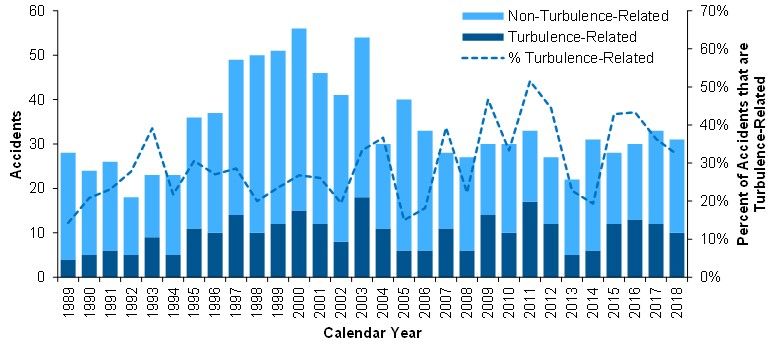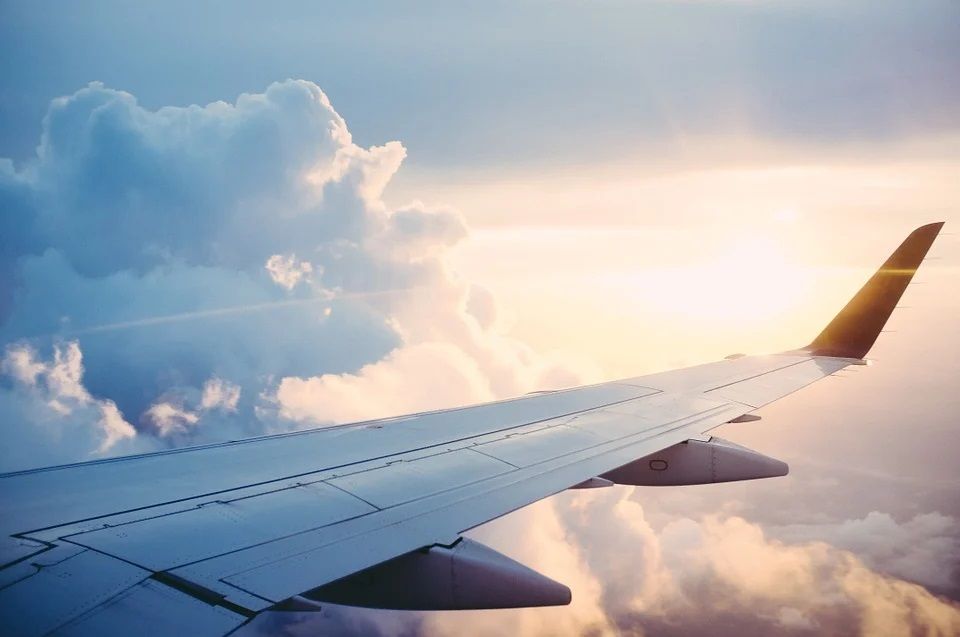The National Transportation Safety Board (NTSB) is asking the FAA, National Weather Service and airline industry associations to take steps to reduce the number of turbulence-related injuries in Part 121 air carrier operations. Citing a recent safety research report that found that more than one-third of all Part 121 air carrier accidents in the U.S. involving a serious injury are caused by turbulence, the Board called on the organizations to focus specifically on improving turbulence-encounter reporting and turbulence forecasting. It further recommended that the FAA update and streamline its systems for collecting and sharing turbulence reports.
“Pilot reports of turbulence conditions are a tremendous help to both pilots and forecasters to predict and avoid hazardous turbulence and subsequent injuries,” said NTSB Acting Chairman Bruce Landsberg. “The majority of injuries occurred below 20,000 feet in the vicinity of thunderstorms so it’s critically important for both passengers and flight attendants to be seated with their seat belts fastened in those conditions.”
In addition, the NTSB recommended that the FAA and NWS work together to fully implement the turbulence nowcast, a new weather product that “combines numerous data sources to produce forecasts that are updated every 15 minutes.” The complete safety research report is expected to be published in the next few weeks. The report, which reviewed accidents from 2009 through 2018, also noted that injuries to flight attendants accounted for nearly 80 percent of turbulence-related injuries in Part 121 ops.





































All of the NTSB members should ride on an airline flight together in stormy weather so that they can all see for themselves how difficult and in most cases impossible to get passengers to listen and obey the seat belt signs when they are illuminated. I even had injuries on a medical positioning flight to flight nurses who should have known better due to their ignoring the seat belt sign when I encountered turbulence. I sympathize with the flight attendants who get hurt during these events. I have no sympathy for passengers who get hurt or injure others because they refuse to follow instructions or the seat belt sign.
I can tell the airlines and NTSB why the problem got so bad. I haven’t flown commercial in years, but your post confirms the same problem from when I was using airlines, no one respects the seatbelt sign. Now that could be because no one respects anything anymore, especially airlines.
In this case though, there is a phenomenon in the electronic sign business. If your sign lies, it dies. We all can likely relate to some warnings we get too often and inappropriately. I learned about this selling the signs to call centers. If a customer told me the signs were not modifying behavior, I knew the problem was managers, not the signs. They were using the sign to get what they wanted rather than to help the help the agents meet the groups goals. A subtle difference in theory, but in practice it can be as subtle as a kick in the head.
For the airlines, the seatbelt light has been used to control passengers rather than keep them safe. It is no longer a safety device. Don’t even try to argue with me, it’s true. The FA’s know it, they mostly don’t try to enforce it anymore.
If an airline wants to win, they need to start using the light only for safety. Then, once they get that beat into the heads of their crews, they need to make a funny video making fun of some crew that outrageously uses the sign to control the passengers while some poor sod suffers from needing to go to the toilet or something. They will get a win, and the industry will change.
Have to concur. After flight after flight during which you’ve sat through multiple “lockdowns” without encountering the advertised turbulence the old cry wolf syndrome sets in. This is just human nature at work, and it doesn’t matter what the flight crew motivation was. No idea what can be done about it, of course, but simply blaming the public for their reaction is non-productive.
Much of the time they don’t even bother to claim turbulence. They reach cruise, pull out the cart, serve the cabin, and THEN the light goes out.
Seat belts work wonders when used. Since that is too complicated and ignored by the flying public, soon the NTSB will be petitioning the FAA with NTSB inspired recommendations including rulemaking for installation and proper operation of airliner airbags. MOSIAC and warbird flight instruction rules will take years to formulate. However, I predict airliner airbag regulations to take only a few weeks. Shortly thereafter, I will receive an AD for my old Bonanza requiring me to retrofit my airplane with similar side, front, and overhead airbags. ?%$# always rolls downhill.
I don’t understand this neo popular anti-NTSB bandwagon onto which even normally sane sounding people are jumping these days? Nothing in this story even closely suggests that the NTSB is being unreasonable and going all airbag on us. What I did read in this story besides, yes, please everyone fasten seatbelts and that includes FAs, is that the NTSB is recommending the FAA and NWS work better together to fully implement a new weather product referred to as the turbulence nowcast using available data to produce forecasts updated every 15 minutes. Sounds like a good idea to me. I don’t know about you, but I have wished many times for such a feature in the real world.
Delta Airlines has a proprietary app that has been used successfully for 5 years that shares turbulence reports automatically to it’s airborne fleet, even to the specific aircraft type.
https://news.delta.com/groundbreaking-app-helps-delta-pilots-avoid-turbulence
Thanks.
Delta web weenies place a large blue block over much of the article. But if you click on a link that is visible you can see the simple graphic at least.
Do modern weather radars help?
CAT is an old problem that people have researched to predict.
Except in first class or business class, the seats on commercial airliners are not designed for much passenger comfort. Flying to coast-to-coast for 5 hours without getting out of your seat while the seat belt sign is on is a good way to get deep vein thrombosis, back problems and pee in your pants. Turbulence is a problem but confining everyone to their seats for most of the flight isn’t the answer. Better ways of predicting turbulence and coupling the activation of the seat belt signs to the turbulence predictor might help. So would making seats more comfortable and spacing them out more even if it sacrifices some profit in return for more passenger comfort. I think the airlines’ goals of maximizing aircraft passenger capacity and route profitability are already skating the edge of passenger abuse. Why don’t they just anesthetize each passenger after boarding and wake them up at after landing? That would also solve the problem of disruptive passengers.
“Why don’t they just anesthetize each passenger after boarding and wake them up at after landing?”
Didn’t they do that in “Demolition Man”?
Me, I’d just love it.
When I’ve traveled by airline, I have my seat belt tight during takeoff and landing, but loosen it once we’ve reached cruise altitude. It will still keep me in the seat should we hit unforecast turbulence, but also allow me to be a bit more comfortable in the seat (at least, as comfortable as one can be in an airline seat). And if I need to get up and walk around, I’ll do that when the seatbelt sign isn’t on.